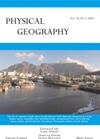喜马拉雅西北部赞斯卡山脉南部晚全新世黄土和中间古土壤的气候意义
IF 1.1
4区 地球科学
Q4 ENVIRONMENTAL SCIENCES
引用次数: 0
摘要
亚洲中纬度地区的黄土-古土壤代用记录有助于重建区域古气候演变及其与全球气候变化的关系。本研究探讨了西北喜马拉雅赞斯卡尔山脉南部黄土-古土壤序列(LPS)的离散产状。沉积物结构的地层变化,加上地球化学、有机和磁性指标,表明黄土增生(L-1)和古土壤形成(PS-1)两大阶段。古黄土(L-1)沉积期在2.5±0.3 ka ~ >2.0 ka之间,而完全转变为现代土壤(MS)的黄土(L-2)沉积期可能在小冰期(LIA)。黄土的结构特征(含砂量高)表明其源近端沉积,而地球化学和磁性指标则表明其沉积前风化作用(在源区)。PS-1测定值为2189±296 calyr BP,表明水汽条件有所改善,而MS测定值为LIA后暖相。这些发现为更好地理解SZR黄土增生和古土壤形成与晚全新世气候变率的敏感性提供了重要的一步。本文章由计算机程序翻译,如有差异,请以英文原文为准。
Climatic implications of late Holocene loess and intervening paleosols, Southern Zanskar range, northwestern Himalaya
ABSTRACT The loess-paleosol proxy records from mid-latitude Asia have been instrumental in the reconstruction of regional paleoclimate evolution and its relationship with global climatic changes. The present study explores the discrete occurrence of a loess and paleosol sequence (LPS) in the Southern Zanskar Range (SZR), NW Himalaya. Stratigraphic variations in sediment texture, supplemented with geochemical, organic and magnetic proxies, indicate two broad phases of loess accretion (L-1) and paleosol formation (PS-1). The older phase of loess accretion (L-1) is dated between 2.5 ± 0.3 ka and >2.0 ka, whereas the L-2, which fully transformed into the modern soil (MS) probably deposited during the Little Ice Age (LIA) phase. The textural attributes (high sand content) of loess indicate source proximal deposition, whereas the geochemical and magnetic proxies point towards the pre-depositional weathering (in the source area). The PS-1 dated to 2189 ± 296 cal yr BP indicates improved moisture conditions, whereas the MS is assigned to post LIA warm phase. These findings provide an important step towards better understanding the sensitivity of loess accretion and paleosol formation in the SZR linked to late Holocene climate variability.
求助全文
通过发布文献求助,成功后即可免费获取论文全文。
去求助
来源期刊

Physical Geography
地学-地球科学综合
CiteScore
3.60
自引率
0.00%
发文量
18
审稿时长
6 months
期刊介绍:
Physical Geography disseminates significant research in the environmental sciences, including research that integrates environmental processes and human activities. It publishes original papers devoted to research in climatology, geomorphology, hydrology, biogeography, soil science, human-environment interactions, and research methods in physical geography, and welcomes original contributions on topics at the intersection of two or more of these categories.
 求助内容:
求助内容: 应助结果提醒方式:
应助结果提醒方式:


